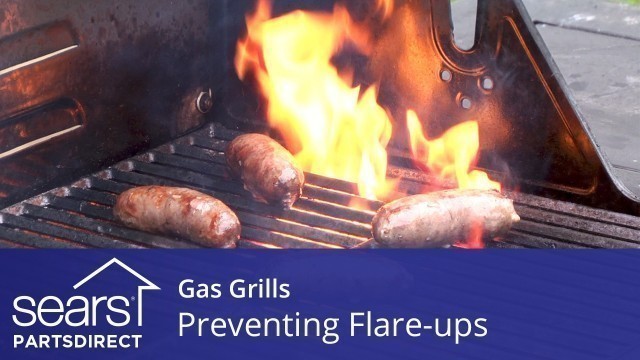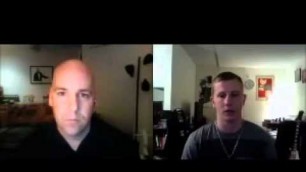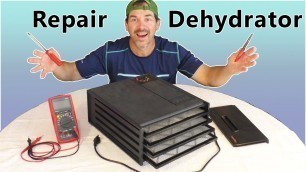

'This video from Sears PartsDirect shows how to prevent flare-ups on a gas grill. The most effective way to prevent flare-ups is to make sure that your flame tamers are clean and free from corrosion and holes. Also, make sure the grease pan below the burners is clean and in good shape. Finally, using the right cooking methods for fatty meat and sausages helps avoid dangerous flare-ups. Following these tips will help you cook your meat safely and avoid and out of control fires. Visit us at https://www.searspartsdirect.com?sid=soc:preventing-flare-ups-on-a-gas-grill Or call 1-800-437-1673 to speak with a parts specialist. The video includes these parts and tools. Look up your model to make sure you get the right parts for your grill. Flame tamers https://www.searspartsdirect.com/part-number/812-7109-S/0071/125.html?sid=soc:youtube:direct-part-link Drain pan https://www.searspartsdirect.com/part-number/50500015/0071/146.html?sid=soc:youtube:direct-part-link CO2 Fire extinguisher https://www.searspartsdirect.com/part-number/57202/0009/009.html?sid=soc:youtube:direct-part-link Find parts for grill at https://www.searspartsdirect.com/partsdirect/product-types/Grill-Smoker-Parts?sid=soc:youtube:grill-parts Or click here to schedule an appointment with a repair technician. https://www.searshomeservices.com/repair#showall Transcript: Flame tamers are your number 1 defense against flare-ups—if they’re clean. Flame tamers cover the grill burners and burn off grease as it drips onto the flame tamer. This burn-off creates smoke, which flavors the food you\'re grilling. But the flame tamers need to be relatively clean for that smoke to happen. If you let the flame tamers collect grease, they can cause flare-ups instead of preventing them. Clean dirty flame-tamers thoroughly before you preheat the grill. If you notice just a few drips of grease or light residue on the flame tamers when you\'re preparing to grill, preheat the grill to clean the flame tamers before cooking. To clean them when they\'re really dirty, pull off the grates and remove the flame tamers. Scrape off the big chunks of grease and food, and then use a grill brush to remove remaining residue. Wash the flame tamers with a cloth dipped in a mild solution of grease-cutting dishwashing liquid and water. Rinse the flame tamers with clean water and then reinstall the flame tamers and grates. Replace any rusted or damaged flame tamers. Grease can build up on rust, causing a flare-up. Rust holes in the flame tamers let grease drip directly onto burners, which also can cause a flare-up or even a fire. Another source of flare-ups is too much grease and debris in the grease pan below the burners. Old, dried grease left in the pan will liquefy, vaporize and then burn as the grill heats up. Check the grease pan before firing up your grill and clean it if you find heavy residue. The grease pan on this grill is removable so I can pull it out and clean it thoroughly. If your grill doesn\'t have a removable grease pan, remove the grates, flame tamers and possibly the burners to thoroughly clean the bottom of the burner box or the grease pan. Replace the grease pan if you find severe corrosion or damage such as rust holes during cleaning. Fatty meat also can cause flare-ups. Flame tamers can only burn off a reasonable amount of fat drippings, so trim excess fat from meat before cooking to help avoid flare-ups. These tips will help you prevent flare-ups. But what do you do if you’re grill is already on fire? You can close the lid to smother a small flare-up. For large flare-ups, pull the meat off the grill or move it so it can cook with indirect heat. What’s that, you ask? It\'s an area on your grill where you leave a burner or two off so meat roasts on heat from the adjacent burners when you close the lid. An indirect heating area won\'t produce the searing heat that can start a fire. You should only cook some meats such as fatty sausage or untrimmed pork roast over indirect heat because flame tamers can only tame a reasonable amount of fat drippings. Cooking fatty meats above direct flames can cause extreme flare-ups. Before you position the meat over indirect heat, you usually need to heat the meat or sausage over direct heat to initially increase the internal temperature. Watch the meat closely and quickly move it to the indirect heat as soon as it drips fat. When heated, some sausages squirt fat and juices out, creating a flamethrower effect. Keep a close eye on your grill when cooking fatty sausages and meats to prevent an uncontrollable fire. Here\'s one final tip. Always keep a CO2 fire extinguisher handy when grilling. You never know when a fire can grow out of control. Use a CO2 fire extinguisher on grill fires rather than water because CO2 safely extinguishes and smothers grease fire flames. Water will spread a grease fire.'
Tags: video , grill , gas grill , grease fire , Sears PartsDirect , Sears Parts Direct , flame tamers , corroded flame tamer , clean flame tamer , clean grease pan , smother flames , fire extinguisher , Co2 fire extinguisher , trim meat , prevent grease fire
See also:







!['Brazilian Grilled Chicken Sandwich | Noah\'s Food + Drink Reviews [Ep 13]'](https://cdn-img01.foodbl0g.com/images/40-m/139/139014_m.jpg)









comments